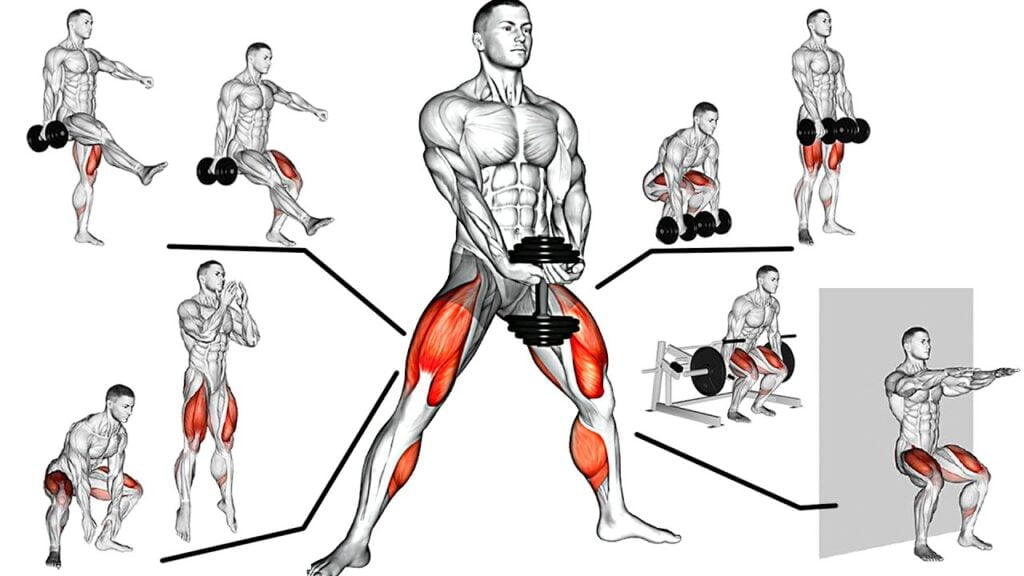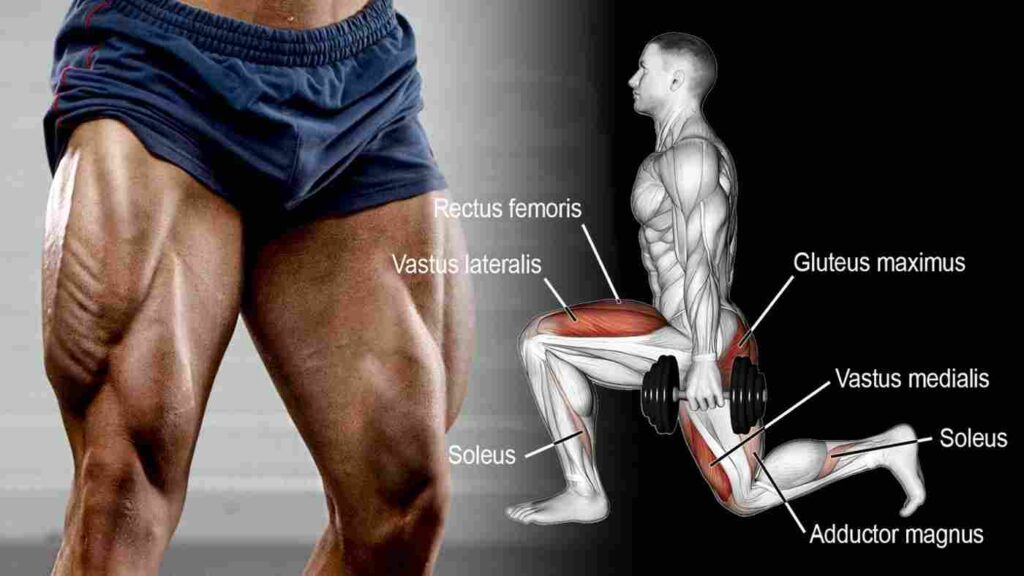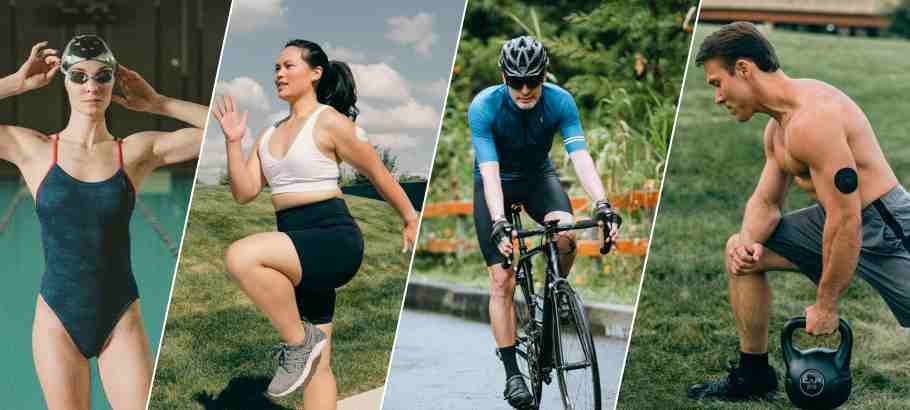Introduction
The gluteal muscles, also known as the glutes, are a group of three muscles in the buttocks: the gluteus maximus, gluteus medius, and gluteus minimus. These muscles play a crucial role in movement and exercise, as they are responsible for hip extension, abduction, and rotation. Strong, activated glutes can improve athletic performance, reduce the risk of injury, and enhance overall body composition.
However, many people struggle with inactive glutes due to prolonged periods of sitting, poor posture, and other lifestyle factors. When the glutes are inactive, other muscles such as the lower back and hamstrings may compensate for their weakness, leading to imbalances and increased risk of injury. Inactive glutes can also contribute to poor posture, which can lead to chronic pain and discomfort.
To combat these issues, Effective Glute Activation Exercises can be incorporated into your workout routine. These exercises focus on targeting and activating the glutes to improve their strength and function. By incorporating Effective Glute Activation Exercises into your routine, you can improve your athletic performance, reduce the risk of injury, and enhance overall body composition.
How to Activate Your Glutes
To effectively activate your glutes, there are a few steps you can take:
- Mind-muscle connection: One of the most effective ways to activate your glutes is to establish a mind-muscle connection. This involves focusing on contracting and squeezing your glutes during exercises that target them. The key is to consciously think about engaging the glutes throughout the movement, rather than just going through the motions. To do this, try to visualize your glutes contracting and tightening as you perform each exercise.
- Engaging the glutes before exercise: Before starting your workout, it’s a good idea to perform a few glute activation exercises to “wake up” your glutes and prepare them for the work ahead. This can include exercises like glute bridges, clamshells, or donkey kicks, which are all effective glute activation exercises that can be done with just your bodyweight.
- Using resistance bands or weights to increase activation: Another way to increase glute activation is by using resistance bands or weights during your exercises. Resistance bands can be wrapped around your thighs or ankles during exercises like squats or lunges to provide extra resistance and help activate your glutes. Meanwhile, using weights like dumbbells or barbells during exercises like hip thrusts or deadlifts can also increase glute activation. The key is to choose a weight that is challenging but still allows you to maintain proper form and technique.
Glute Activation Exercises
“Effective Glute Activation Exercises” are exercises that specifically target and engage your glute muscles to help improve their strength and activation during other exercises and daily activities. Here are a few examples of such exercises:
Bodyweight exercises

- Glute bridge: Lie on your back with your knees bent and feet flat on the ground. Engage your core and glutes to lift your hips off the ground, forming a straight line from your knees to your shoulders. Squeeze your glutes at the top and hold for a few seconds before lowering back down.
- Clamshells: Lie on your side with your knees bent and feet together. Keeping your feet together, lift your top knee as high as you can while keeping your hips stacked. Squeeze your glutes at the top and hold for a few seconds before lowering back down.
- Donkey kicks: Start on your hands and knees with your wrists directly under your shoulders and your knees directly under your hips. Keeping your knee bent, lift your right leg up and back towards the ceiling until your foot is higher than your butt. Squeeze your glutes at the top and hold for a few seconds before lowering back down. Repeat on the other side.
- Fire hydrants: Start on your hands and knees with your wrists directly under your shoulders and your knees directly under your hips. Keeping your knee bent, lift your right leg out to the side, keeping your knee at a 90-degree angle. Squeeze your glutes at the top and hold for a few seconds before lowering back down. Repeat on the other side.
Resistance band exercises
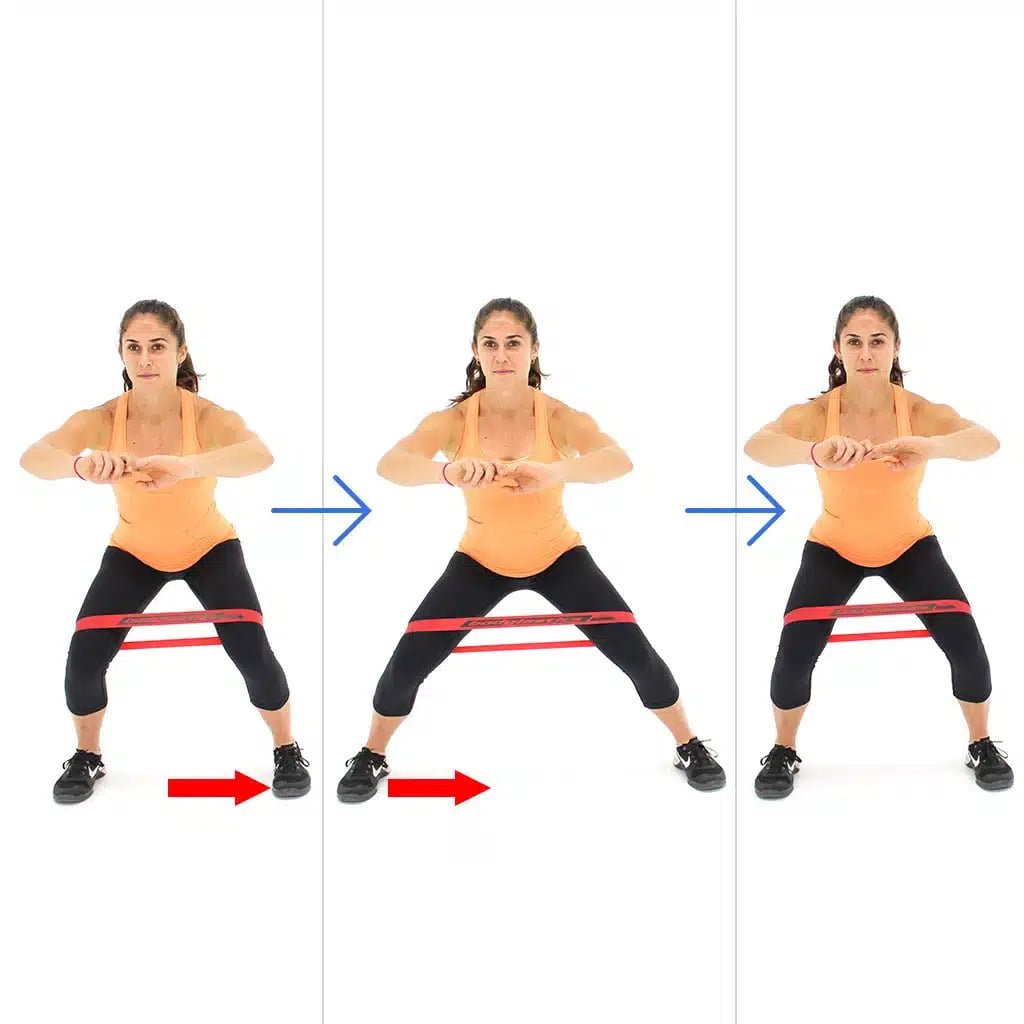
- Lateral band walks: Place a resistance band around your ankles and stand with your feet hip-width apart. Take a step to the side with your right foot, keeping tension on the band. Bring your left foot in to meet your right foot. Repeat for a few steps in one direction before going the other way.
- Monster walks: Place a resistance band around your ankles and stand with your feet hip-width apart. Take a step to the side with your right foot, then take another step with your left foot, so your feet are wider than hip-width apart. Keep taking steps to the side, maintaining tension on the band.
- Glute bridges with band: Place a resistance band around your thighs, just above your knees. Lie on your back with your knees bent and feet flat on the ground. Engage your core and glutes to lift your hips off the ground, forming a straight line from your knees to your shoulders. Squeeze your glutes at the top and hold for a few seconds before lowering back down.
Weighted exercises
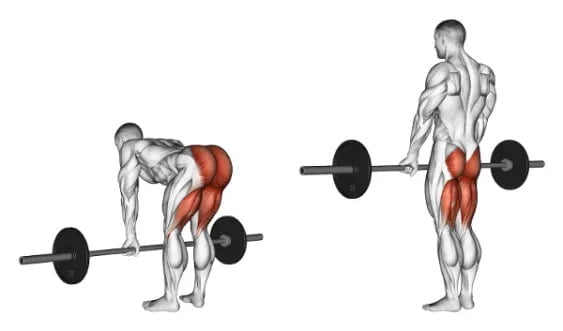
- Barbell hip thrusts: Sit on the ground with your back against a bench and a barbell across your hips. Your feet should be flat on the ground and your knees bent. Engage your core and glutes to lift your hips off the ground until your body forms a straight line from your knees to your shoulders. Squeeze your glutes at the top and hold for a few seconds before lowering back down.
- Romanian deadlifts: Stand with your feet hip-width apart and a barbell in front of you on the ground. Hinge at your hips and bend your knees slightly to grab the barbell with an overhand grip. Keeping your back flat, use your glutes and hamstrings to stand up straight, lifting the barbell off the ground. Squeeze your glutes at the top and hold for a few seconds before lowering back down.
- Cable pull-throughs: Set up a cable machine with a rope attachment at the lowest setting. Stand facing away from the machine with the rope between your legs. Hinge at your hips and bend your knees slightly to grab the rope behind you. Keeping your back flat, use your glutes and hamstrings to stand up straight, pulling the rope through your legs until your body forms a straight line from your knees to your shoulders. Squeeze your glutes at the top and hold for a few seconds before lowering back down.
Tips for Maximizing Glute Activation
- Mind-muscle connection: When performing Glute Activation Exercises, it’s important to focus on the target muscle group, which in this case is the glutes. By mentally focusing on the glutes and visualizing them contracting during each rep, you can create a stronger mind-muscle connection, which can lead to better muscle activation and overall muscle development.
- Proper form and technique: Maintaining proper form and technique is crucial to effectively target the glutes and avoid injury. When performing exercises such as Glute Bridges, Clamshells, or Barbell Hip Thrusts, it’s important to keep a neutral spine, engage your core, and avoid using other muscle groups such as your lower back or hamstrings to compensate for weak glutes.
- Gradually increase resistance and difficulty: Like any muscle group, the glutes need to be challenged in order to grow and develop. By gradually increasing the resistance or difficulty of your Glute Activation Exercises, such as by adding weight or using a resistance band, you can continue to challenge your glutes and promote muscle growth.
- Consistency and frequency: Consistency is key when it comes to effectively activating your glutes. Try to incorporate Glute Activation Exercises into your warm-up routine before your workouts, and aim to perform them 2-3 times per week. This will help to keep your glutes activated and improve their overall strength and function.
- Incorporate a variety of exercises: To effectively target different parts of your glutes, it’s important to incorporate a variety of Glute Activation Exercises into your workouts. This can include exercises such as Donkey Kicks, Fire Hydrants, or Cable Pull-Throughs, which target different parts of the glutes and help to keep your workouts challenging and interesting.
By following these tips, you can effectively activate your glutes and maximize the benefits of your Glute Activation Exercises.
Common Mistakes When Trying to Activate Your Glutes

Here are some common mistakes people make when trying to activate their glutes with effective glute activation exercises:
- Focusing too much on the number of reps instead of the quality of movement
- Not engaging the glutes properly and relying on other muscles (such as the lower back) to do the work
- Not activating the glutes before compound lower body exercises, can lead to other muscles taking over and potential injury
- Using too heavy of weights and sacrificing proper form and technique
- Not using a full range of motion, which can limit the activation of the glutes
- Neglecting bodyweight exercises in favor of weighted exercises, can hinder progress and activation of the glutes
- Not incorporating variety in the exercises, can limit the effectiveness and progress of the glutes
- Not using proper breathing techniques, such as exhaling on the concentric (lifting) phase of the movement to activate the glutes more effectively.
By avoiding these common mistakes and focusing on effective glute activation exercises with proper form and technique, you can better activate your glutes and improve your overall lower body strength and performance.
Progressions for Glute Activation Exercises
Here are some explanations of progressions for effective glute activation exercises:
Advancing from bodyweight to weighted exercises
Bodyweight exercises are a great starting point for glute activation, but in order to continue making progress and challenging your muscles, you need to add resistance. Weighted exercises such as barbell hip thrusts and Romanian deadlifts are effective glute activation exercises that can provide a greater challenge to the glute muscles. As you progress, you can gradually increase the weight you are lifting to continue challenging your glutes.
Incorporating instability training
Instability training involves adding an unstable surface or object to your exercises, which can help to improve overall balance and stability while also activating the glutes to a greater extent. Exercises such as single-leg squats or step-ups on a balance ball or wobble board can be effective for incorporating instability training into your glute activation routine.
Increasing resistance or difficulty of resistance band exercises
Resistance bands are a popular tool for glute activation exercises, as they provide constant tension on the muscles throughout the movement. To increase the difficulty of resistance band exercises, you can use a band with greater resistance, or perform the exercises for longer periods of time. Additionally, you can incorporate different variations of resistance band exercises, such as lateral band walks with a squat, to add more challenge to the glute muscles.
By incorporating these progressions for effective glute activation exercises into your fitness routine, you can continue to challenge your muscles and see improvements in strength, stability, and overall glute development.
Combining Glute Activation Exercises With Other Lower Body Exercises
When it comes to lower-body workouts, it’s essential to activate your glutes to ensure proper movement patterns and reduce the risk of injury. Here are two points about combining glute activation exercises with other lower body exercises:
Integrating glute activation exercises into leg day workouts
Effective Glute Activation Exercises can be incorporated into a leg day workout routine to target the glutes and improve overall lower body strength. For example, you can start with a warm-up that includes bodyweight exercises such as glute bridges, clamshells, donkey kicks, or fire hydrants. Then, you can add compound exercises such as squats, lunges, and deadlifts that incorporate the glutes. Finally, you can finish the workout with more isolated glute exercises, such as hip thrusts, to maximize glute activation.
The benefits of activating the glutes before compound lower body exercises
Activating your glutes before performing compound lower body exercises can improve performance and reduce the risk of injury. When your glutes are activated, they can help to stabilize your hips and pelvis, allowing you to perform exercises with proper form and reduce stress on the lower back. For example, activating your glutes before performing squats can help to prevent your knees from caving inwards and reduce the risk of knee injury. Some Effective Glute Activation Exercises that can be performed before compound lower body exercises include glute bridges, lateral band walks, and monster walks.
In summary, integrating Effective Glute Activation Exercises into your leg day workout routine can improve overall lower body strength and performance. Additionally, activating your glutes before performing compound lower body exercises can help to reduce the risk of injury and improve exercise form.
Targeting Specific Areas of the Glutes
Here’s an explanation of how different glute muscles play a role in movement and exercise, as well as some Effective Glute Activation Exercises that target the upper, middle, and lower glutes:
The role of different glute muscles in movement and exercise
The glutes consist of three main muscles: the gluteus maximus, gluteus medius, and gluteus minimus. Each of these muscles plays a crucial role in movement and exercise.
- Gluteus maximus: This is the largest muscle in the gluteal group and is responsible for hip extension and external rotation. It is activated when you stand up from a seated position, jump, or climb stairs. Exercises that target the gluteus maximus include squats, deadlifts, lunges, and hip thrusts.
- Gluteus medius: This muscle sits on the side of the hip and is responsible for hip abduction and internal rotation. It is activated when you move your leg away from your body or rotate your hip inward. Exercises that target the gluteus medius include lateral band walks, clamshells, and single-leg hip thrusts.
- Gluteus minimus: This muscle is the smallest of the gluteal group and works in conjunction with the gluteus medius to stabilize the hip joint during movement. It is activated when you lift your leg off the ground, such as when you take a step. Exercises that target the gluteus minimus include lateral band walks and single-leg balance exercises.
Exercises that target the upper, middle, and lower glutes
For the upper glutes: Effective Glute Activation Exercises include barbell hip thrusts, glute bridges with weights, and reverse lunges with a focus on squeezing the glutes at the top of the movement.
- Barbell hip thrusts: This exercise targets the upper glutes and involves sitting with your back against a bench, placing a barbell over your hips, and driving your hips up while squeezing your glutes at the top of the movement. This exercise can be done with bodyweight or with added weight.
- Glute bridges with weights: This exercise also targets the upper glutes and involves lying on your back with your knees bent and a weight placed on your hips. You then raise your hips towards the ceiling while squeezing your glutes at the top of the movement.
- Reverse lunges: This exercise targets the upper glutes and involves stepping backward with one leg and bending both knees to lower your body towards the ground. As you push back up, focus on driving through your heel and squeezing your glutes.
For the middle glutes: Effective Glute Activation Exercises include squats with a band around the knees, lateral band walks, and single-leg hip thrusts.
- Squats with a band around the knees: This exercise targets the middle glutes and involves placing a resistance band around your knees and squatting down, keeping your knees pushed out against the band to activate the glutes.
- Lateral band walks: This exercise targets the middle glutes and involves placing a resistance band around your ankles and walking sideways while keeping tension on the band to activate the glutes.
- Single-leg hip thrusts: This exercise targets the middle glutes and involves lying on your back with one leg extended, placing the other foot on the ground, and driving your hips up while squeezing your glutes.
For the lower glutes: Effective Glute Activation Exercises include Romanian deadlifts, cable pull-throughs, and step-ups with a focus on driving through the heel to activate the glutes.
- Romanian deadlifts: This exercise targets the lower glutes and involves standing with a barbell in front of you and hinging at the hips while keeping your back straight, then driving your hips forward to stand up while squeezing your glutes.
- Cable pull-throughs: This exercise targets the lower glutes and involves standing facing away from a cable machine with a rope attachment around your waist, then pulling the cable through your legs while squeezing your glutes at the end of the movement.
- Step-ups: This exercise targets the lower glutes and involves stepping up onto a box or bench with one leg while driving through your heel and squeezing your glutes at the top of the movement.
It’s important to choose a variety of Effective Glute Activation Exercises to target all areas of the glutes and to focus on proper form and technique to prevent injury and maximize results.
The Benefits of Glute Activation Exercises for Specific Populations
Here are the benefits of effective glute activation exercises for specific populations:

Athletes and Sports Performance
Effective glute activation exercises can improve athletic performance in a variety of ways. Strong glutes are crucial for generating power and explosiveness in many sports, such as sprinting, jumping, and throwing. In addition, properly activated glutes can help to stabilize the pelvis and prevent injury during high-intensity activities. Some effective glute activation exercises for athletes include barbell hip thrusts, Romanian deadlifts, and cable pull-throughs.
Older Adults and Injury Prevention
As we age, our glutes can become weaker and less active, which can increase the risk of falls and other injuries. Effective glute activation exercises can help to strengthen the glutes, improve balance and coordination, and reduce the risk of falls. In addition, strong glutes can help to alleviate lower back pain, which is a common issue among older adults. Some effective glute activation exercises for older adults include bodyweight exercises like clamshells and donkey kicks, as well as resistance band exercises like lateral band walks and monster walks.
Individuals with Sedentary Lifestyles or Jobs
People who have sedentary jobs or lifestyles may have inactive glutes due to prolonged sitting. This can lead to poor posture, lower back pain, and a variety of other issues. Effective glute activation exercises can help to activate and strengthen the glutes, improve posture, and alleviate lower back pain. Some effective glute activation exercises for individuals with sedentary lifestyles include bodyweight exercises like glute bridges and fire hydrants, as well as resistance band exercises like glute bridges with bands and lateral band walks.
In summary, effective glute activation exercises can benefit athletes by improving their performance and preventing injury, older adults by reducing the risk of falls and alleviating lower back pain, and individuals with sedentary lifestyles or jobs by improving posture and reducing lower back pain.
Conclusion
In conclusion, effective glute activation exercises can be beneficial for people of all ages and fitness levels. By properly activating and strengthening the glutes, individuals can improve athletic performance, reduce the risk of injury, alleviate lower back pain, and improve posture.
Athletes can benefit from exercises like barbell hip thrusts and Romanian deadlifts, while older adults can benefit from exercises like clamshells and lateral band walks. Individuals with sedentary lifestyles can benefit from exercises like glute bridges and fire hydrants. Regardless of your fitness level or lifestyle, incorporating effective glute activation exercises into your routine can help to improve your overall health and wellbeing.

Good day, and welcome to Fitthour. My name is Shubham Vijay, and I am a certified personal trainer and nutrition coach with 6 years of experience in the fitness industry. At Fitthour, we specialize in types of training, such as strength training, cardio, or HIIT, and our mission is to help clients achieve their fitness goals and improve their overall health.

